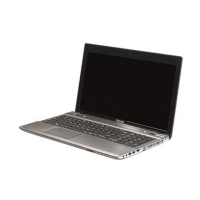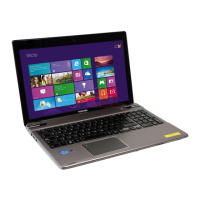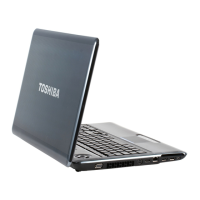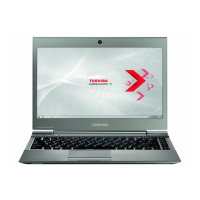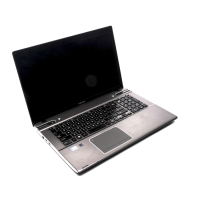
Do you have a question about the Toshiba P875 and is the answer not in the manual?
| Battery | 6-cell Lithium-ion |
|---|---|
| Connectivity | Wi-Fi 802.11 b/g/n, Bluetooth 4.0 |
| Processor | Intel Core i7-3610QM |
| RAM | DDR3 |
| Display | 17.3-inch, 1600x900 |
| Graphics | NVIDIA GeForce GT 630M |
| Operating System | Windows 7 |
| Optical Drive | DVD SuperMulti |
| Weight | 6.6 lbs (3.0 kg) |
| Dimensions | 16.3 x 10.6 x 1.3 inches (414 x 269 x 33 mm) |
| Ports | HDMI, VGA, Ethernet, headphone/microphone combo jack |
| Audio | Harman/Kardon speakers |
Lists all items included with the computer for setup.
Instructions on how to connect the AC power adapter to the computer.
Procedure to power on the computer for the first time or subsequent uses.
Steps for safely shutting down the computer in different modes.
Methods to restart the computer when it encounters issues or requires a reset.
Overview of the computer's front when the display is closed.
Identification and description of ports and features on the computer's left side.
Identification and description of ports and features on the computer's right side.
Overview of the computer's front when the display is open.
Explanation of how to use the remote controller for computer functions.
Description of key internal hardware components like CPU and HDD.
Instructions on how to use the touchpad for cursor control and operations.
Explanation of keyboard layout, indicators, and key types.
Overview of the computer's wireless communication capabilities.
Details on connecting to a Local Area Network (LAN).
Safety precautions and information for handling memory media cards.
Description of audio control functions like volume mixer and microphone level.
Description of pre-installed software utilities and how to start them.
Explanation of unique or advanced features for enhanced computer usability.
Details on battery types, care, and use.
Tips and factors influencing battery life and how to extend it.
Instructions on how to safely remove and install the battery pack.
Guidelines for systematically identifying and resolving computer problems.
A checklist of common hardware and system issues and their potential causes.
Technical data on the computer's physical size and weight.
Technical data on operating and non-operating environmental conditions.
Lists various agencies certifying power cords and connectors for different regions.
Legal footnotes explaining factors affecting battery life.
Legal footnotes regarding Wireless LAN transmission speed and distance.
Information on Wireless LAN compatibility with other systems.
Safety information on potential health effects of wireless devices.


